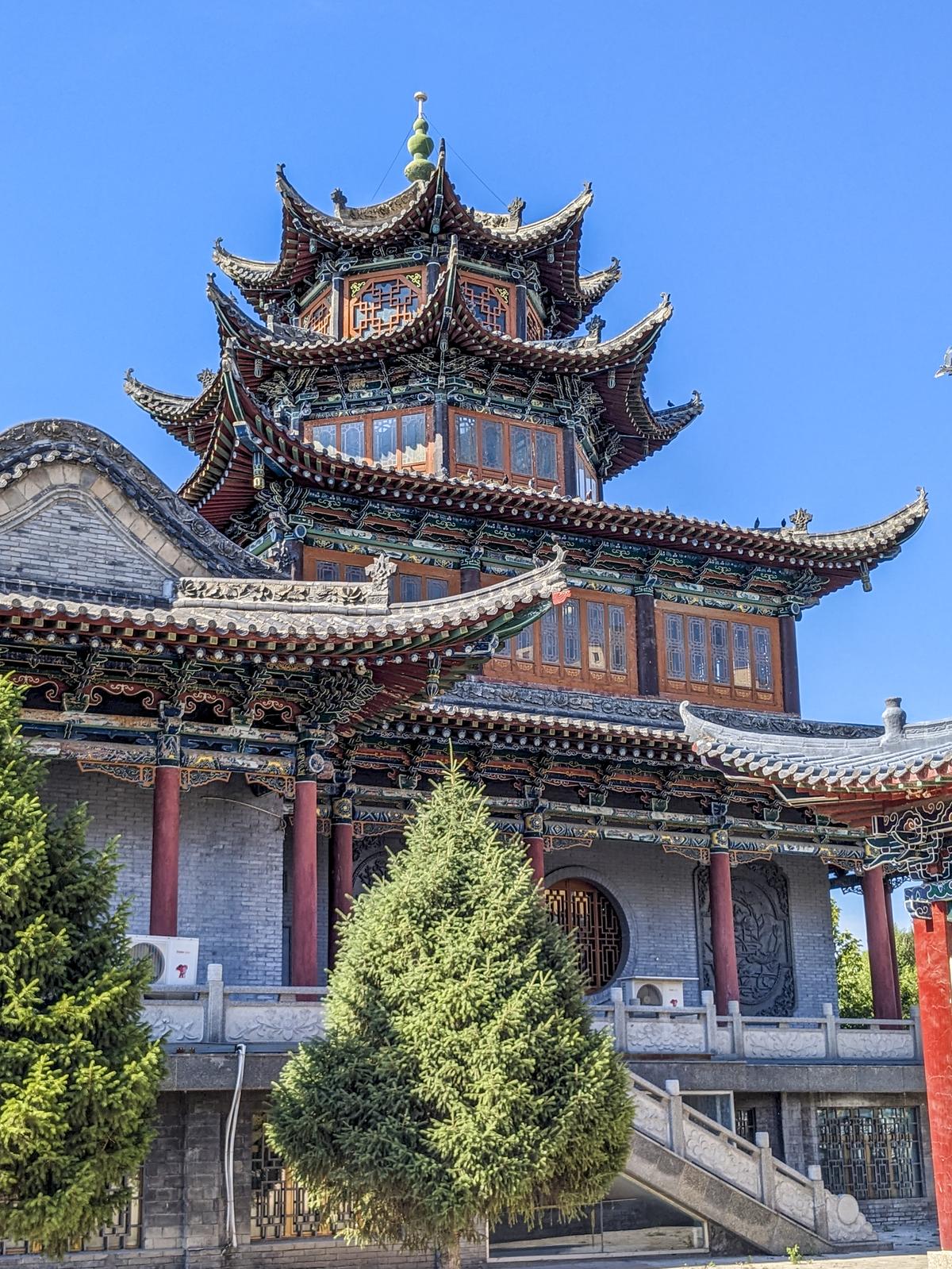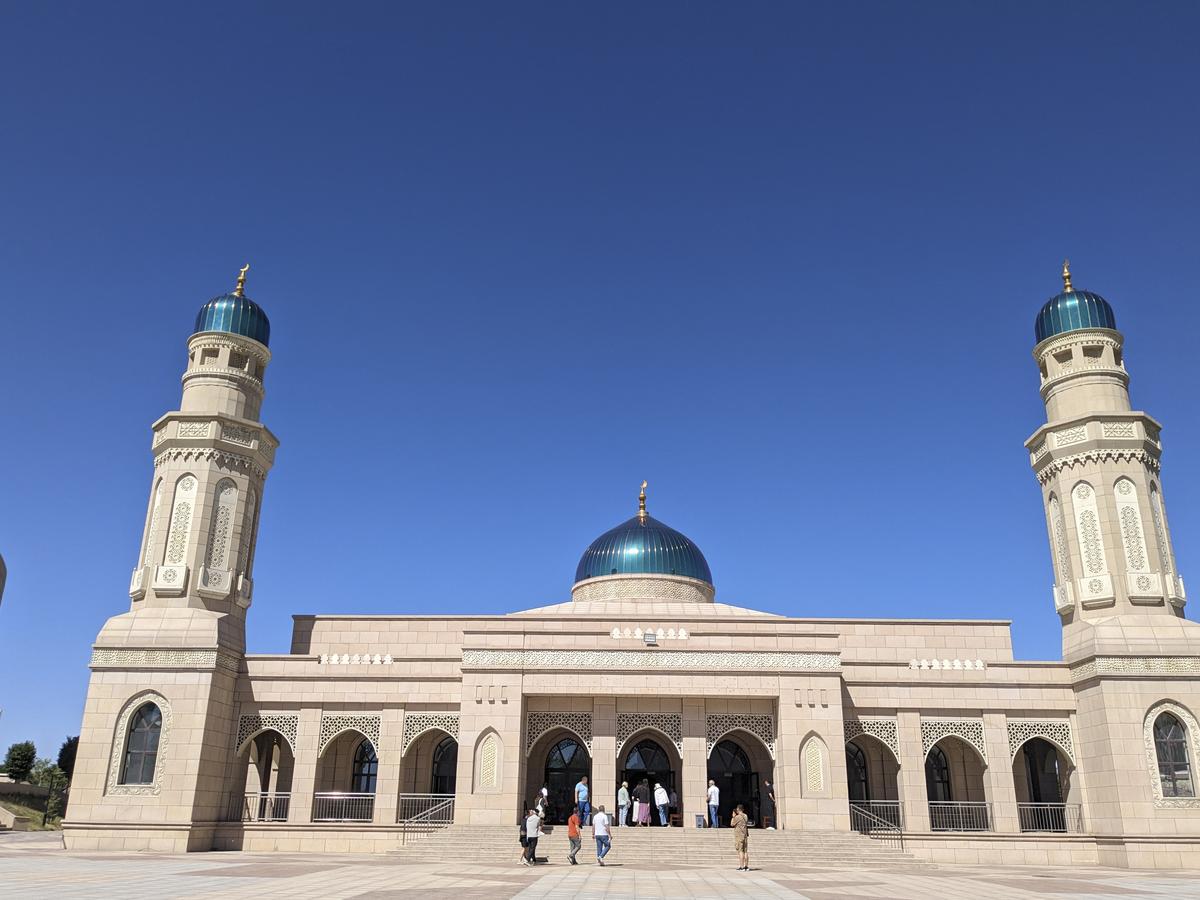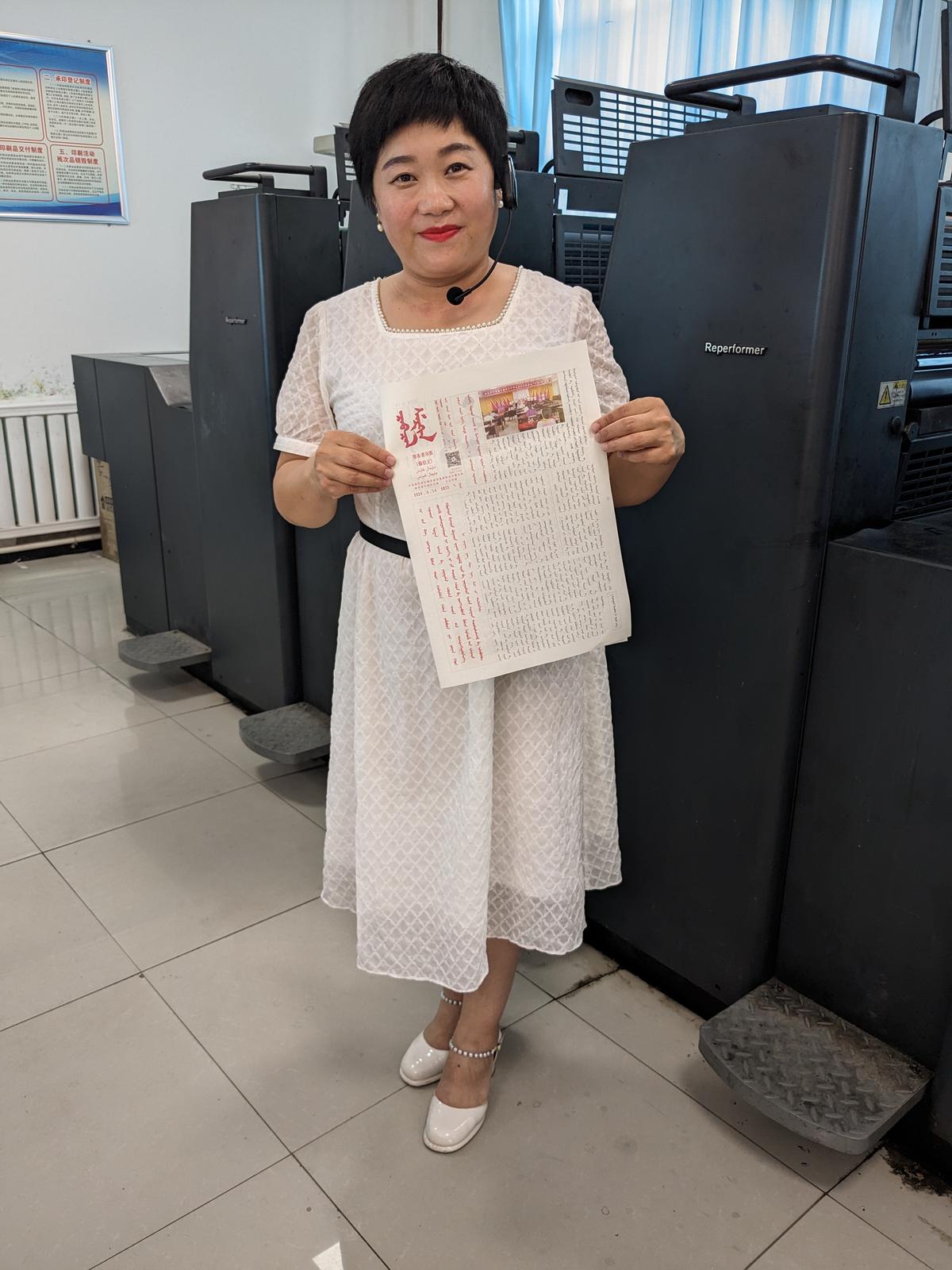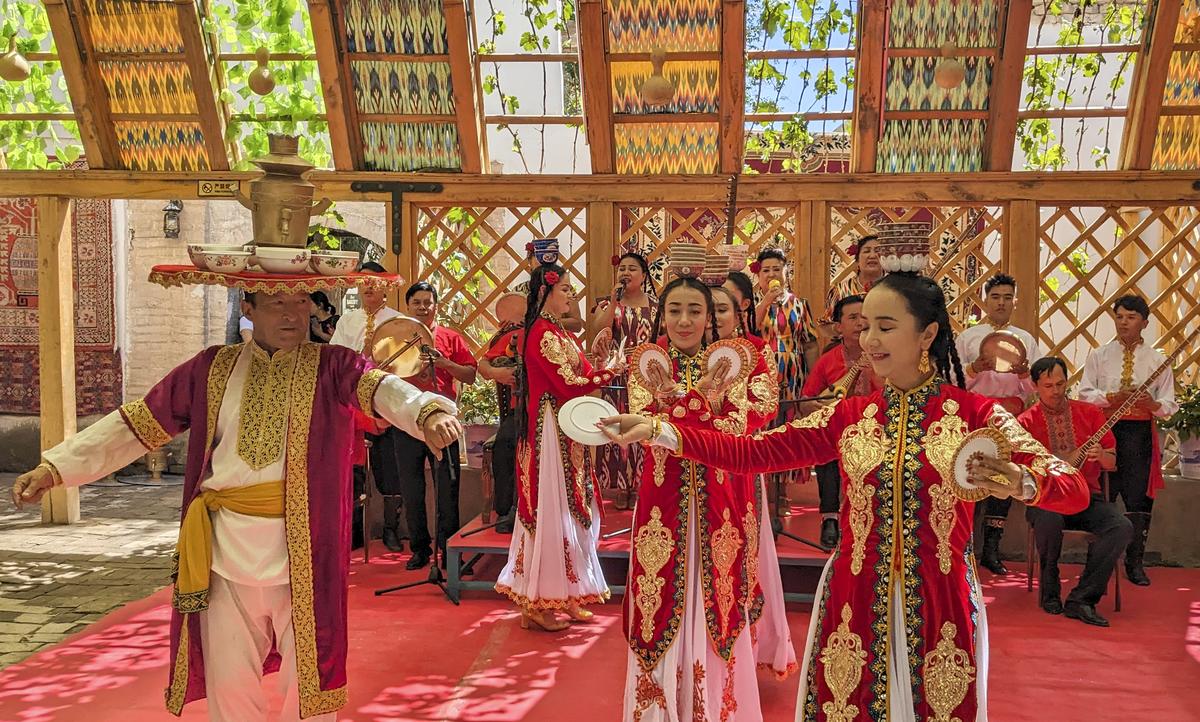Nine musicians wearing brilliant outfits assemble on stage on the centre of an accordion museum in Yining metropolis in Xinjiang province, China. It’s June 17, the day of Eid-Ul-Adha, and everyone seems to be in celebratory temper. 1000’s of vacationers and locals have gathered on Liuxing avenue regardless of the warmth to get pleasure from avenue meals, watch swish performances, and drink chilled recent juice and beer.
Within the museum filled with devices, every musician holds an accordion. Earlier than bursting into tune, they introduce themselves, not by identify however by ethnicity – Uyghur, Kazhak, Mongolian, Uzbek, and so forth. Then, in refrain, they shout cheerfully in English, “We’re all a part of the Chinese language nation.”
The proclamation of nationwide unity and the fastidiously curated variety on stage, significantly on the event of Eid, is important. Xinjiang Uyghur Autonomous Area, positioned in northwestern China, is house to 56 ethnic teams, together with the Uyghur, Kazakh, Mongol, Manchu, Uzbek, Xibe, and Russian, who’re all termed “ethnic minorities” by the state. The huge province is house to followers of many religions akin to Islam, Taoism, Buddhism, and Christianity.
For years, China has confronted accusations from human rights teams of committing crimes towards humanity of principally Muslim ethnic teams within the area. In response to a number of stories, together with by the United Nations Human Rights Workplace, and Human Rights Watch, the Chinese language had been detaining Uyghurs, who type the vast majority of the ethnic minorities, in “detention centres” and subjecting them to abuse.

The Chinese language Communist Celebration (CCP) has rubbished these claims. It has repeatedly argued that these will not be “detention centres” however “training and vocational coaching centres”. A booklet issued by the State Council Data Workplace says these centres had been established with the “aim of training and rehabilitating individuals responsible of minor crimes or law-breaking, and eradicating the affect of terrorism and extremism.” In 2019, nevertheless, the Chairman of the Xinjiang regional authorities introduced that these centres can be progressively wound down “if society not wanted them.”
Numerous research have additionally claimed that the inhabitants of the Han Chinese language, the nation’s dominant ethnic group, has grown within the area, whereas the Uyghur inhabitants has declined ever for the reason that Individuals’s Republic of China took over the province in 1949.
Nevertheless, official knowledge present that the Uyghur inhabitants, which was 3.6 million within the first nationwide inhabitants census of 1953, grew to 11.6 million (222%) within the seventh census of 2020. The rise has been attributed partly to the truth that Uyghurs and different minorities, together with the agricultural inhabitants, had been exempt from China’s decades-old one-child coverage.
The ‘Sinicisation’ of faith
On the Shaanxi mosque, an necessary heritage web site in Yining, the Imam, Ma Jirong, says all these accusations are “vastly exaggerated”. He factors in direction of the mosque, the place 1,300 Muslims had assembled to wish that morning. “Since you’re right here, you’ll be able to see for your self,” he says. “International nations have a hatred in direction of China. It is sort of a tumour of their physique.”
The centuries-old mosque behind him, painted in purple and darkish blue, is constructed within the “conventional palace model of Chinese language structure,” in response to the information. The construction is manufactured from wooden and brick and showcases the characteristically Chinese language upturned eaves. The dome and minarets, generally present in a number of mosques world wide, are lacking. The decision to prayer could be heard solely inside the premises. The ceiling is painted with flowers and vegetation, and journalists from West Asia marvel loudly in regards to the absence of Arabic script on the within partitions.

The Shaanxi mosque in Yining, which is is constructed within the conventional palace model of Chinese language structure.
| Photograph Credit score:
Radhika Santhanam
Ma shrugs off these observations. “It’s a Chinese language mosque,” he says. “Mongolian, Uyghur, and lots of different ethnic communities participated in its building. It exhibits that Xinjiang is an inseparable a part of Chinese language territory.”
This adaptation of faith to Chinese language traits, and particularly to Chinese language socialism, is what Abud Rakev Tumunyaz, the Imam on the Xinjiang Islamic Institute at Kuqa, 280 kilometres away, refers to as “Sinicisation”.

“Faith has no nationwide boundaries, however believers have a motherland. Chinese language individuals belong to the Individuals’s Republic of China, so faith ought to adapt to socialism in China,” Tumunyaz, 62, contends.
Ma believes there isn’t any contradiction between Chinese language socialism and Islam. “Each prioritise the happiness of the individuals,” he says.
The mosque at Kuqa has a dome and minarets. Contained in the Islamic Institute’s sprawling library, which homes about 30,000 books, the Imam flips by means of the copies of the Koran laid neatly on a desk. The certain books look new and the pages crackle when flipped. There are copies in Uyghur, Arabic, and Chinese language. Newspapers in Mongolian, Uyghur, and different languages are stacked in a rack within the studying space.

The mosque on the Xinjiang Islamic Institute of Kuqa.
| Photograph Credit score:
Radhika Santhanam
Nevertheless, similar to the remainder of the nation, Xinjiang promotes customary Chinese language in public instructional establishments; college students say classes will not be taught in Uyghur or different languages. Uyghur is spoken all over the place, however store indicators are principally solely in Chinese language.
A authorities booklet claims that ethnic minorities are “enthusiastic” about studying and utilizing customary Chinese language. It says ethnic teams are “inspired to study spoken and written languages from one another… (emphasis added)” and ethnic languages are “extensively utilized in areas akin to judicature, administration, training, press and publishing, radio and tv…”

A small newsroom and the printing press of a county-level newspaper referred to as Chabuchar Day by day, introduced out within the Xibo or Xibe language, are showcased as proof of this. The four-page tabloid, which interprets newspaper stories into Xibo, which is carefully associated to Manchu, a virtually extinct language, is introduced out twice every week for the 30,000 audio system of Xibo in Xinjiang. “As you’ll be able to see, the federal government cares about ethnic cultures and languages,” says one of many editors, Zhao Jinxiu.

Zhao Jinxiu, one of many editors of the Chabuchar Day by day tabloid, which is printed within the Xibe language.
| Photograph Credit score:
Radhika Santhanam
Deradicalisation programme
Each Ma and Tumunyaz emphasise the significance of “legal guidelines and laws” and firmly state that Islam ought to “develop accordingly”. When requested to quote an instance of how the legislation dictates the follow of faith, Tumunyaz says, “The federal government designates areas the place prayers and different spiritual actions can happen.”
On the Islamic Institute at Kuqa, college students are given spiritual training, which incorporates studying to recite the Koran. They’re taught Chinese language tradition and historical past, and Islamic historical past from the time it was launched in China about 1,300 years in the past. They examine classes in regards to the civil code, and legal guidelines and laws relating to faith. In addition they endure a ‘deradicalisation programme’.
The Chinese language argue that this stems from Xinjiang’s troubled historical past. Within the final twenty years, the area has seen many terror assaults. In 2012, knife-wielding terrorists attacked civilians in Kashgar, leaving 15 useless. In Could 2014, attackers crashed vehicles into buyers and threw explosives, killing greater than 30 individuals within the capital metropolis of Ürümqi. In July the identical yr, an Imam in Kashgar was stabbed to demise. China has blamed the East Turkestan Islamic Motion, which was based by militant Uyghur separatists, for a few of these assaults.
The struggle towards what the federal government calls the “three evils of extremism, terrorism, and separatism” can also be China’s rationale for the “training and vocational coaching centres.” In written communication with the media, the CCP says by means of these centres, Xinjiang has “destroyed 1,588 violent and terrorist gangs, arrested 12,995 terrorists…, punished 30,645 individuals for 4,858 unlawful spiritual actions, and confiscated 3,45,229 copies of unlawful spiritual supplies” since 2014. The curriculum on the centres, it says, “begins with studying customary spoken and written Chinese language language, then strikes onto learning the legislation, and concludes with studying vocational expertise”.
Ready for freedom
Nevertheless, a number of Uyghurs have publicly spoken and written about how they didn’t select to go to those centres. Many critics have additionally raised questions on why distinguished Uyghur intellectuals, writers, and artists had been despatched to locations that purportedly present “vocational expertise”.
Many ethnic minorities have additionally fled China fearing unwell therapy at these centres. In 2013, three Uyghurs — Adil, Abdul Khaliq, and Salamu — from Kargilik in southwest Xinjiang crossed the border into Ladakh in India with none journey paperwork. They had been apprehended by the Indian Military, which handed them over to the Indo-Tibetan Border Police. Later, the three of them had been handed over to the native police. They’ve been in jail since.
“All of the three younger males, one in all whom was a minor then, fled to India saying Uyghurs had been being persecuted of their nation,” says Mohammad Shafi Lassu, a lawyer in Leh who’s representing them. “They stated they’d seen all types of atrocities. They got here to India as a result of they knew that Pakistan would hand them again to China. However in India, after finishing their sentence, they had been booked below the draconian Public Security Act in 2015.” The Jammu and Kashmir Public Security Act, 1978, is a preventive detention legislation below which an individual is taken into custody in order that they won’t act in a fashion that’s prejudicial to “the safety of the state or the upkeep of public order”.
Lassu sounds drained. “I’ve little hope for his or her future,” he says. Aside from the stringent legislation, he additionally cites India’s neutrality on the Uyghur query as a cause for his despair. In 2022, the nation abstained on a draft decision on the United Nations Human Rights Fee on holding a debate on human rights in Xinjiang, arguing that it “favours a dialogue to cope with these points” as a substitute.
It is not uncommon chorus in China that “worldwide forces had been influencing individuals over the online”; for this reason the federal government additionally additional tightened its management over the Web, a transfer defended as ‘cyber sovereignty’. Assured now that terrorism is a factor of the previous, Xinjiang additionally has an ‘exhibition of anti-terrorism and anti-extremism’.
The worry of assault had turned Xinjiang right into a safety zone by all accounts. This appears to have principally dissipated, besides in components such because the Worldwide Grand Bazaar in Ürümqi, the place males in uniform examine foreigners’ passports on the entrance and a safety van with armed males is completely stationed outdoors.
Tumunyaz says “faith will not be extremism and vice versa”; but shows of overt religiosity are clearly frowned upon and will land individuals in jail. “The deradicalisation programme will not be about focusing on any faith or ethnic minority,” he says. “We’ll strike down any separatist.”
Tumunyaz, who can also be the president of the Xinjiang Islamic Institute and vice chairman of the Chinese language Islamic Affiliation, is anticipating two extra delegations within the afternoon. He says delegates from the United Nations visited him final week. He seems to be the designated level individual in Kuqa for all Islam-related questions.
Thrust on growth
The message that the nation comes first, earlier than ethnicity and faith, is assertive additionally given Xinjiang’s strategic location. The province borders Mongolia, Russia, Kazakhstan, Kyrgyzstan, Tajikistan, Afghanistan, and India. As a consequence, it’s of nice significance to China’s mammoth Belt and Highway Initiative (BRI), which facilitates commerce and commerce throughout the traditional Silk Highway routes that related Asia, West Asia, and Europe for about 1,500 years, from the start of the Han dynasty in 130 BCE. Xinjiang was an necessary part of the traditional Silk Highway, which is why the province, characterised by three mountains and two basins, is now referred to as the core space of the Silk Highway financial belt.
This has at all times been one in all China’s poorest areas, however the thrust on growth is obvious to the attention. Ürümqi, Yining, and Kuqa all boast wonderful infrastructure, delivered with what the information calls “Chinese language effectivity”. There are extensive roads with biking and strolling paths lined with timber. Industries together with textiles, energy, manufacturing, and petrochemicals have sprung up all over the place. Xinjiang’s GDP rose from about $167.2 billion in 2017 to $278.4 billion in 2022.

In Kuqa Qiuz Alley, a sprawling previous Uyghur house, whose residents have lengthy since moved out, has been transformed into an space for vacationers to expertise Uyghur tradition.
| Photograph Credit score:
Radhika Santhanam
Being central to the BRI has additionally meant that Xinjiang now generates important income from tourism ($14.1 billion in 2022). In Jiayi village in Xinhe county in Yining, vacationers flock to an exhibition centre of musical devices, which is offered as ‘intangible cultural heritage’. In Kuqa Qiuz Alley, a sprawling previous Uyghur house, whose residents have lengthy since moved out, has been transformed into an space for vacationers to “expertise Uyghur tradition”. The Grand Bazaar comprises a museum of big naans, and retailers promoting Uyghur caps and outfits manufactured from Atlas silk. Professor James Leibold at La Trobe College, Melbourne, who’s an skilled on the politics of ethnicity and race in China, refers to this as “museum-style multiculturalism”, whereas the Chinese language in Xinjiang are at pains to level out how that is in reality “safety of ethnic minority tradition”.
All over the place journalists are taken, there may be an emphasis on how ethnic teams are a part of the BRI. On the meeting workshop of the Car Guangzhou Automobile Motor Firm, the place workers and robots work collectively, the Basic Supervisor, Luo Haitian, says, “Our workers is diversified; about 20% of them are ethnic teams.”

An meeting workshop of the Guangzhou Atutomobile Group Co Ltd, Xinjiang. The province is essential to China’s Belt and Highway Initiative.
| Photograph Credit score:
Radhika Santhanam
On the Xinjiang Software program Park, established in 2015, Yang Qing, director of the division of communications, says, “The event of this park is a part of our strategic plan to develop 5 hubs within the financial belt of Xinjiang. Our aim is to be a provider of the Digital Silk Highway. We offer technical help for the soundness of society of Xinjiang and for high-quality financial growth.”
Yang factors to numerous merchandise and purposes which have made each the every day lives of the individuals in addition to surveillance by the state and the individuals — of site visitors, grazing cattle, motion, and so forth. — simpler.
Her level on high-quality financial growth is borne out by knowledge. However how does technical help guarantee stability? “This area was as soon as influenced by terrorism,” Yang explains. “So now, we monitor the whole lot.”
The author travelled to Xinjiang Uyghur Autonomous Area as a part of a delegation of worldwide journalists from 16 nations hosted by the State Council Data Workplace of the Individuals’s Republic of China




